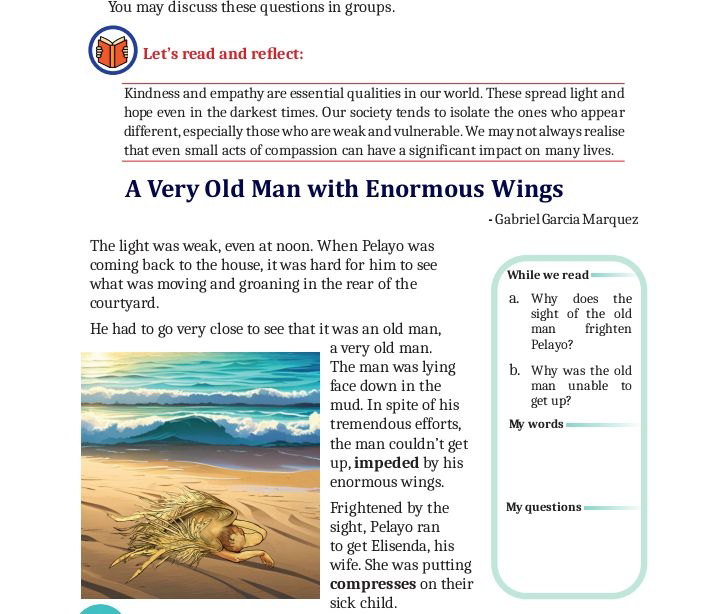Ode To Autumn - John Keats
ODE TO AUTUMN
- John Keats
Introduction:
John Keats son of a stable keeper was born on 1795. He was the youngest of romantic poets who had an early demise at the age of 26. Keats lived aloft from men and from all political
measures, worshipping beauty like a devotee, perfectly content to write what was in his own heart, or to reflect some splendor of the natural world as he saw or dreamed it to be. He strongly believed
that poetry existed for its own sake. Like all other romantic poets he too was a nature lover and appreciated beauty in everything. Keats is best known for his six odes all of which were written in 1819. They are "Ode on a Grecian Urn", "Ode on Indolence", "Ode on Melancholy", "Ode to a
Nightingale", "Ode to Psyche" and "Ode to Autumn.” An ode is a lyrical poem praising or glorifying an event or individual.
The poem consists of eleven lined three stanzas which describes the natural progression of seasons, from the ripeness of the crops and its harvest and to the last day of autumn when winter is nearing. There are powerful images drawn from the nature through the personification of Autumn, and the description of its abundance, its beauty and its songs.
In English literature the period from 1790-1850 is often termed as the Romantic period (19th century). There was a new feeling and return to nature from the rules and reason of the preceeding century. Many historical events of the times slowly paved way for the romantic era. The French Revolution in 1789, American Declaration of Independence of 1776 and the Reform bill in England were some of them. The slogans of French Revolution, 'Liberty, fraternity and equality' brought a fresh thinking in people's mind. Beauty, inspiration and imagination were the concerns of Romantic poets. The greatest poets of the period were William Wordsworth, Samuel Taylor Coleridge, John Keats, Percy Bysshe Shelley, Lord Byron and Robert Southey.
Exercises:
Choose The Right Answer From The Following
1. In which year was the "Ode to Autumn" written?
1819
2. With whom was Keats engaged in 1819?
Fanny Browne
3. The figure of speech used in the line 'the bosom friend of maturing sun' is....
Personification
Answer the following questions in a sentence or two each
1. Why is autumn called the 'seasons of mists and mellow fruitfulness'?
Autumn is the season of early mist and ripe fruits.
2. Who is called the bosom friend of maturing sun?
Autumn season is called the bosom friend of maturing sun.
3. What constitutes the music of autumn?
The wailing of small gnats, bleating of lambs, singing of crickets, whistling of robin and the twittering of swallows.
4. Which feminine image was used by Keats to describe the autumn?
The image of the Greek harvest goddess, Ceres. Autumn is also personified as a winnower reaper,gleaner and cider presser.
5. What makes the poet to put the question," where are songs of the spring?" The poet is missing the songs of the spring, he wants songs to accompany autumn's beauty.
6. Explain: “Barred clouds bloom the soft dying day,/And touch the stubble plains with rosy hue.”
The evening is approaching, the sky turns into a rosy shade with scattered clouds in the sky.
7. Why is it said that summer has overbrimmed the clamy cells of bees?
The bees have tasted honey from the late autumn flowers until they are satiated.
8. What is the wailful choir described by Keats in the III stanza?
The cry of gnats (small insects).
Answer the following questions in a paragraph not exceeding 100 words each. 1. How does the poet personify autumn in Keats's poem?
In the poem "to autumn", the season is personified in various ways. In the first stanza the
season is personified as "bosom friend" of the sun. They are also said to be "conspiring" on how to
yield a rich ripened harvest. In the second stanza Autumn is personified as a goddess. Here Keats
might have given allusions to the Greek goddess of harvest, Ceres. She is also personified as a
gleaner and a cider presser. In the last stanza there is description of the "soft dying day" which
equates with death.
2. Comment on Keats's treatment of nature.
Every minute aspect of the season is picturesquely described in the poem. it tells about the colours, ripeness of the fruits and vegetables and the harvest. It also gives a picture of bees swarming around flowers yet to bloom. Autumn is also a time vigorous activity. The vegetables are to be collected and sorted out on a granary floor, apples are to be pressed to make cider and all the harvest are to be stored for the upcoming winter. It also talks about the songs of insects and
crickets, robins and swallows and lambs bleating at the end of the day.
3. What characterizes the music of autumn?
Music is a combination of sounds. Nature has its own music. Autumn's music is as varied as its beautiful colours. The "wailful choir"of gnats, crickets, bleating lambs, whistling robins and twiterring swallows constitute the music of Autumn.
4. Explain the lyrical imagery in "Ode to Autumn".
The poem is rich in imagery, evoking the perceptions of sight, hearing, smell, taste and touch. Each stanza highlights one of the senses. The morning mists are felt and mellow fruitfulness is photographic. Also the sweet smelling flowers and bees attracting to honey filled flowers are
appealing to the senses. The sense of sight is emphasized in the second stanza. Autumn personified as a women is seen
sitting carelessly, her hair lifted in the breeze. The third stanza appeals to the sense of listening, the mellifluous song of autumn.
Answer the following questions in not more than 300 words.
1. " Ode to Autumn is one of the thematically rich odes of English literature. Discuss.
The central theme of the poem is ripeness and maturity. There is a sense of acceptance about the inevitability of the seasonal cycles. The beauty of Autumn is a matter of permanence but in real in should also pave way for the winter to come. In this understanding there likes the true Keatsian joy as he writes in Endymion- " A thing of beauty is a joy forever."
Each of the three stanzas concentrates on a dominant aspect of Autumn, but also admits and absorbs its opposites as Keats vision of not considering things in isolation. Keats rejoices, first in the relationship of season, sun and earth and then in fruition that stems from that relationship. The themes in the first stanza is conceive, growth and ripeness. Here all is ripeness. Growth is
surprisingly going on Sun and Autumn are conspiring 'to set budding more and still more.' The cottage-tress bend, under the load of fruit, the vines hang tensely under the weight oc grapes. The stanza is packed in sweetness and nourishment. Autumn celebrates the effortless fruitfulness of nature. The totality of natures dependence is shown when the later flowers are set budding , 'for
the bees', thus connecting the three kingdoms of plant, animal and human. The bees are deceived into feeling that summer will never end. There is a blessing in everything.
In the second stanza the theme of abundance is connected with human labor. A broader landscape is described with granaries and furrows. Autumn is personified as a winnower, a gleaner and a cider-presser. First Autumn is seen as a winnower sitting near her store with her hair flowing in the wind. She is also a reaper sometimes, resting near a half-reaped furrow. Autumn is also represented as a gleaner going home with fruits 'across a brook'. And finally she is seen as a cider presser crushing her apples and watching patiently the last oozings out of the juice for hours.
The last stanza has nostalgia and reminiscence as its theme. The poet is reminded of the song of spring and then he realizes' not to pine for what is lost' for Autumn has its own music. The
close of the year is associated with sunset. The sense of sadness is merged in the feeling of the continuous life of nature, which externally renews itself in the "wailful choir" of insects, bleating
of lambs and whistling and twittering of birds. The feeling of pathos, though solemn breathes the spirit of hope.
2. How does Keats convey the theme of death and rebirth through death in “Ode to Autumn?”
Among the six wonderful odes of Keats to autumn occupies a distinct place of its own, for it is, in execution, the most perfect of his odes. Keats explores the themes of life in death and death in life in ‘Ode to Autumn’ through the imagery, metaphoric language and philosophical
ideas used in the poem. The concept of death is subtle, it is implied as an underlying tone of the poem. Autumn itself signifies ‘shedding off’ which metaphorically stands for death. Autumn is a part of the year as old age is of life. Keats has accepted autumn and connotatively old age as natural real life changes. The human forms to which autumn takes shape in the second stanza is then moving on to the real activities taking place around, in the third stanza.
To Autumn portrays Keats’s attitude as almost in appreciation or awe of the inevitability of change and death due to the re-birth that follows as shown with the unexpected lively sounds of crickets and red breasts whistling. The poet uses different imagery to show the gradual time
change. The ‘soft dying day’ is compared to the ending of the season. The small insects and crickets sing a “wailful choir” at the end of the day/season. Peace is in the soft music of nature as there is contentment in the old age while being nostalgic about youth (“where are the songs of Spring?”) then rebirth occurs and this cycle begins once again. Change is both beautiful and natural.
Although the poem contains only three stanzas, Keats has been successful in expressing the beauty, charm, the symphony of autumn and ageless human activities in the lap of nature. The poem blends living and dying, the pleasant and unpleasant because they are inextricably one; he accepts the reality of mixed nature of the world.



Comments
Post a Comment
Please share your feedback and questions